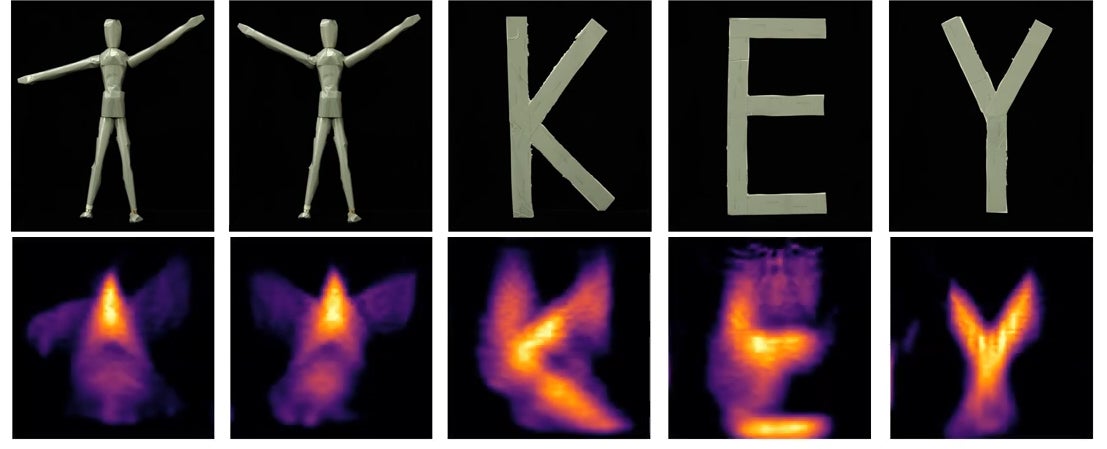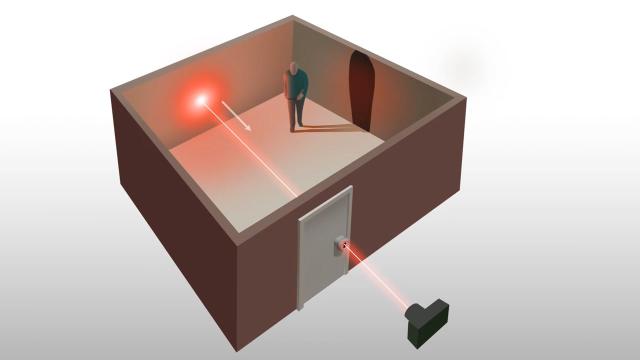Being able to see inside a closed room was a skill once reserved for super heroes. But researchers at the Stanford Computational Imaging Lab have expanded on a technique called non-line-of-sight imaging so that just a single point of laser light entering a room can be used to see what physical objects might be inside.
Non-line-of-sight (NLOS, for short) imaging is by no means a new idea. It’s a clever technique that’s been refined in research labs over the years to create cameras that can remarkably see around corners and generate images of objects that otherwise aren’t in the camera’s field of view, or are blocked by a series of obstacles. Previously, the technique has leveraged flat surfaces like floors or walls that are in the line of sight of both the camera and the obstructed object. A series of light pulses originating from the camera, usually from lasers, bounce off these surfaces and then bounce off the hidden object before eventually making their way back to the camera’s sensors. Algorithms then use the information about how long it took these reflections to return to generate an image of what the camera can’t see. The results aren’t high resolution, but they’re usually detailed enough to easily determine what the object in question is.
It’s an incredibly clever technique, and one day it could be a very useful technology for devices like autonomous cars that would potentially be able to spot potential hazards hidden around corners long before they’re visible to passengers in a vehicle, improving safety and obstacle avoidance. But the current NLOS techniques have a big limitation: They’re dependent on a large reflective surface where light reflections coming off a hidden object can be measured. Trying to image what’s inside a closed room from the outside is all but impossible — or at least it was until now.
The keyhole imaging technique, developed by researchers at Stanford University’s Computational Imaging Lab, is so named because all that’s needed to see what’s inside a closed room is a tiny hole (such as a keyhole or a peephole) large enough to shine a laser beam through, creating a single dot of light on a wall inside. As with previous experiments, the laser light bounces off a wall, an object in the room, and then off the wall again, with countless photons eventually being reflected back through the hole and to the camera which utilises a single-photon avalanche photodetector to measure the timing of their return.

When an object hidden in the room is static, the new keyhole imaging technique simply can’t calculate what it’s seeing. But the researchers have found that a moving object paired with pulses of light from a laser generate enough usable data over a long period of exposure time for an algorithm to create an image of what it’s seeing. The quality of the results is even worse than with previous NLOS techniques, but it still provides enough detail to make an educated guess on the size and shape of the hidden object. A wooden mannequin ends up looking like a ghostly angel, but when paired with a properly trained image recognition AI, determining that a human (or human-shaped object) was in the room seems very feasible.
The research could one day provide a way for police or the military to assess the risks of entering a room before actually breaking down the door and storming their way inside, using nothing but a small crack in the wall or a gap around a window or doorway. The new technique could also provide new techniques for autonomous navigation systems to spot hidden hazards long before they become a threat in situations where the previous NLOS techniques weren’t practical given the environment.
